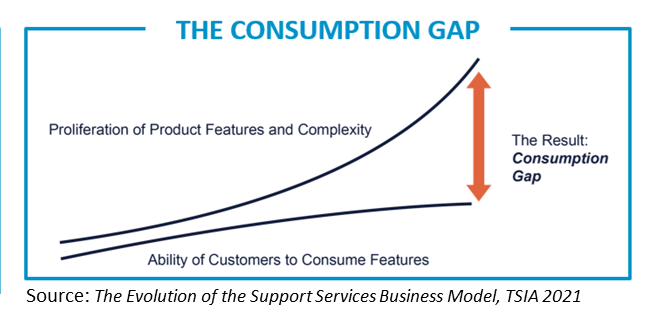Bridging the SaaS Consumption Gap


If you’re a software-as-a-service (SaaS) customer, you’re already enjoying the many advantages of SaaS: no upfront capital expenditure, nearly limitless scalability, and vendor-provided software management, just to mention a few. But is your SaaS app yielding maximum return on investment (ROI)? Unless you’re tapping the app’s full feature set, it’s not.
With SaaS, major product releases occur at a much faster pace than with on-premises software. SaaS vendors often roll out three or four major releases every year. Compare this to on-premises software, which has a major release every one to two years.
Major releases typically deliver major enhancements. That means you’re gaining new capabilities at a much faster rate than in the past. It also means that you have far less time to absorb those new capabilities. Consequently, your users are presented with new features before they’ve had a chance to consume the ones they already have.
 Consequently, the level of consumption of a SaaS app’s feature set is dropping. The result is what the Technology & Services Industry Association (TSIA) calls the consumption gap. Unless you’re leveraging the full power of your SaaS solutions, your organization isn’t deriving the full value from its SaaS investments.
Consequently, the level of consumption of a SaaS app’s feature set is dropping. The result is what the Technology & Services Industry Association (TSIA) calls the consumption gap. Unless you’re leveraging the full power of your SaaS solutions, your organization isn’t deriving the full value from its SaaS investments.
When you implement a SaaS app, you give primary responsibility for support to the SaaS vendor. But SaaS vendors approach support in a completely different way than traditional, on-premises support teams. With on-premises software, the support team’s primary role is break/fix, whereas the primary role of SaaS vendor support teams is to help customers bridge the consumption gap—driving up adoption and increasing ROI.
To achieve this objective, SaaS vendors have disrupted the traditional support model by changing its focus to make it more consultative and more customer centric. They are applying best practices and innovation to attain the level of support their customers demand.
Software support has evolved over the years, becoming increasingly proactive and personalized. There are essentially five stages in this evolution, with each stage delivering an improved level of support.
Different SaaS vendors are at different stages in their support evolution. That’s why it’s important to evaluate the level of support a SaaS vendor is capable of delivering. The higher the level, the more value the vendor can help you gain from your SaaS solution. While you’re at it, look at your internal IT support organization and make sure it’s positioned to work effectively with the SaaS support team, now and into the future.
Be sure to set realistic expectations. Vendors may not necessarily be able to deliver prescriptive support today, but they should be moving in that direction. At a minimum, they need to be at a proactive level. Don’t, however, lose sight of the prescriptive level. It’s the ultimate level of support due to its highly personalized nature, and the gold standard for where forward-thinking SaaS vendors are going.
If you need assistance with your transition to SaaS, please fill out our form and a BMC Customer Success expert will reach out to get started.